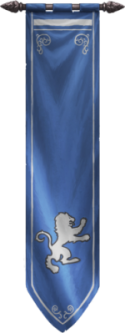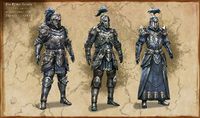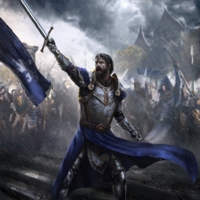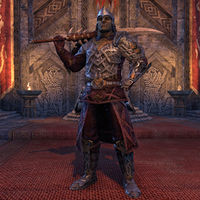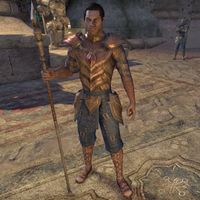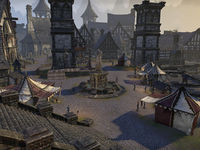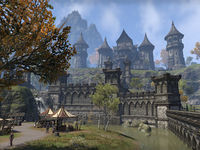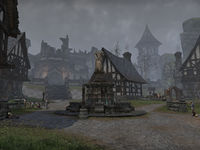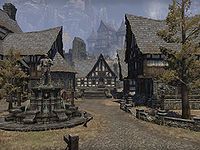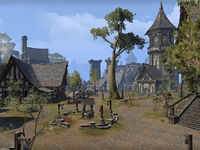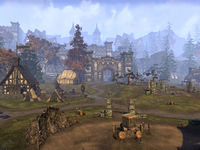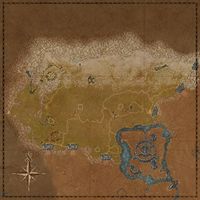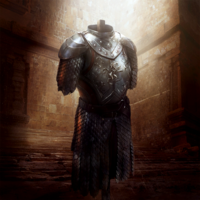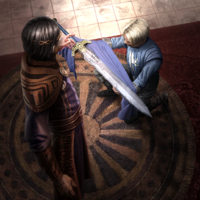Lore:Daggerfall Covenant
- "It is fortunate for our peoples — indeed, for all the peoples of Tamriel — that the true flame of the Empire of Man still burns in the Daggerfall Covenant. These are terrible times, but our destiny lies before us as straight and true as the Reman roads: we must march on Cyrodiil, overthrow the false empress and all her brood, and restore the Empire of Tamriel. Then once more peace and justice will rule the provinces, rather than blood and fire." —High King Emeric
The Daggerfall Covenant was a military alliance between the High Rock kingdoms of Camlorn, Daggerfall, Evermore, Shornhelm, and Wayrest, the northern Hammerfell kingdom of Sentinel and the city of Hallin's Stand, and also Orsinium during the chaotic Interregnum of the Second Era. It vied with the Aldmeri Dominion and Ebonheart Pact for control over the contested Ruby Throne in Cyrodiil. The Covenant saw itself as the successor to the Reman Dynasty and aimed to restore the Second Empire with the legitimacy to rule all of Tamriel.[1] They advocated economic prosperity and the worship of the Divines.[2] In this mission it was led by a Royal Council, presided over by High King Emeric, a Breton merchant lord of superb diplomatic skill.[1] The Redguards were represented by King Fahara'jad, and the Orcs by King Kurog gro-Bagrakh.
The faction gets its name from the treaty of mutual defense that created the first Daggerfall Covenant, which was signed at Daggerfall following Durcorach's failed invasion of High Rock.[3] The Covenant was known for having some of the finest blacksmiths in Tamriel.[4] The Lion Guard was a knightly order that served as the elite and personal guardians of the Greater Daggerfall Covenant's rulers.[5][6] Inspired by the Lion Guard, Emeric adopted the lion as his personal crest and it became the martial symbol of the Daggerfall Covenant.[6] The Ring of Daggers was the intelligence branch of the Covenant, and enforced economic and political issues on the behalf of the faction.[7]
History[edit]
There were actually two Daggerfall Covenants, although the first was made up only of small kingdoms within High Rock. Thus, most references to the Covenant are to the second, or Greater, Daggerfall Covenant which united multiple provinces and races.
First Daggerfall Covenant[edit]
The first Covenant was formed in response to the invasion of High Rock in 2E 542 by Reachmen under the command of Durcorach, the "Black Drake". The invasion was a complete surprise, and was only barely repulsed after months of fighting, led by King Bergamot of Daggerfall and Earl Emeric of Cumberland.[8] In the aftermath, the kings of Daggerfall, Wayrest, Camlorn, Evermore, and Shornhelm signed the Covenant as a defensive pact against foreign threats.[1] The kingdoms rebuilt and prospered, and Emeric ascended to the throne of Wayrest due to the Knahaten Flu.
Greater Daggerfall Covenant[edit]
- "The Covenant represents the continuing ideals of Reman's Imperium, the uncontested height of Tamrielic civilization, when everyone, even the Orcs, were included in history's greatest confederation. Insofar as we seek to restore those lost glories, we deliberately hark back to them in our designs and symbolism." — Crafting Motif 26: Daggerfall Covenant
As king, it was expected that Emeric would wed the daughter of King Ranser of Shornhelm, but in 2E 566 he suddenly married Princess Maraya, the Redguard daughter of King Fahara'jad.[8] This strengthened diplomatic and trade relations between High Rock and Hammerfell, but it also enraged Ranser, who hired a host of mercenaries and stormed Wayrest. The city would have fallen, had not Emeric's shrewd diplomacy paid off.[9] The other kingdoms of High Rock honored their earlier Covenant and came to his defense, while Fahara'jad, now an ally by marriage, sent elite troops across the Iliac Bay. These combined forces were enough to rout Ranser's army, who retreated only to find that their homeland had been sacked in their absence by the Orcs under King Kurog. Emeric had sent an emissary requesting their aid in exchange for a guarantee that Orsinium would be re-established as a sovereign territory.[9] Ranser was utterly crushed, and this new arrangement of alliances formed the second Daggerfall Covenant, aiming to conquer Cyrodiil and succeed the Second Empire.[8]
- →For more detailed information, see: Daggerfall Covenant Campaigns section in the Three Banners War article
In 2E 582, the Covenant invaded Cyrodiil, putting it in direct conflict with the Ebonheart Pact and the newly-formed Aldmeri Dominion. This led to open hostilities and the start of the Three Banners War, with all three sides vying for control of the Daedra-occupied Imperial City. The Covenant also launched a simultaneous naval invasion of the Pact homeland, although it was unsuccessful. The Orcs of Betnikh joined the Covenant soon after. With much of its forces in Cyrodiil, the Covenant faced attacks from Reachmen, necromancers, agents of Vaermina, Molag Bal's forces, and even an Imperial Legion, but managed to repel them all. It also faced political instability in Rivenspire and a potential Crown rebellion against Fahara'jad, and briefly flirted with total collapse following the death of Emeric, although the High King was promptly resurrected. Although it didn't take part directly, the Covenant sanctioned the invasion of Coldharbour which contributed to the ending of the Planemeld.[10] In the autumn, civil war broke out in the region of Wrothgar between the kingdom of Orsinium and several Orc clan chiefs who refused to acknowledge Kurog's rule. The violence ended with the death of Kurog, and Bazrag gro-Fharun was crowned as king of a united Wrothgar. As Emeric's agreement was directly with Kurog and not the clan chiefs, Orsinium's continued membership of the Daggerfall Covenant became a matter of debate for Bazrag.[11]
Tamriel Covenant[edit]
Although their plan was never realized, the leaders of the Covenant intended to crown High King Emeric as Emperor of a third Empire and found a new Imperial dynasty after conquering the Heartlands of Cyrodiil and taking the Ruby Throne. With this achieved, the Covenant would have been in an ideal position to invade and conquer the other two alliances and proclaim the Tamriel Covenant. Under this new empire, the Royal Council would have been replaced by a Grand Council, with a seat for every kingdom in Tamriel.[2] This scenario was not to be, as the Daggerfall Covenant ultimately crumbled; the true Third Empire was proclaimed by Tiber Septim in 3E 0, ending the Interregnum period.[12]
Gallery[edit]
Leaders[edit]
Major Cities[edit]
Miscellaneous[edit]
See Also[edit]
- For game-specific information, see the ESO article.
Books[edit]
- Crimes of the Daggerfall Covenant by Aicantar of Shimmerene, Sapiarch of Indoctrination — Dominion propaganda decrying the Covenant
- Guide to the Daggerfall Covenant — A history and overview of the Daggerfall Covenant
- Triumphs of a Monarch by His Majesty King Emeric — An autobiographical account of the life of King Emeric of Wayrest
- True Heirs of the Empire by Erystera Ligen — Propaganda for the Daggerfall Covenant
References[edit]
- ^ a b c Guide to the Daggerfall Covenant
- ^ a b True Heirs of the Empire — Erystera Ligen
- ^ Ask Us Anything: Daggerfall Covenant (Part 2)
- ^ Loading screen tip in Legends
- ^ The Improved Emperor's Guide to Tamriel: High Rock — Flaccus Terentius, 2E 581
- ^ a b Ask Us Anything: Daggerfall Covenant (Part 1)
- ^ Valaste's dialogue in ESO
- ^ a b c Triumphs of a Monarch — His Majesty King Emeric
- ^ a b The Fury of King Ranser — Wafimeles Masteret (Lorekeeper)
- ^ Events of ESO
- ^ King Bazrag's dialogue in Long Live the King
- ^ Brief History of the Empire v 1 — Stronach k'Thojj III
